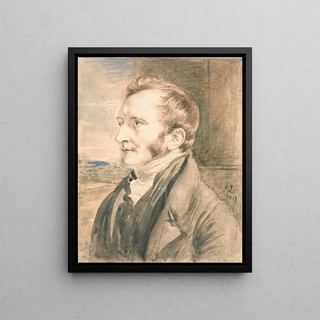Art print | Portrait of a man - John Linnell


View from behind

Frame (optional)
Portrait of a Man - John Linnell – Captivating Introduction
The "Portrait of a Man" by John Linnell is a work that transcends the simple frame of a portrait to become a window into the human soul. This painting, imbued with rare psychological depth, invites viewers to reflect on identity and the human condition. Through the intense gaze of its subject, Linnell manages to capture an essence that goes far beyond physical representation. Every brushstroke seems to whisper secrets, and each shadow evokes buried thoughts. This portrait, in its simplicity, resonates with an emotional complexity that leaves no one indifferent.
Style and uniqueness of the work
Linnell, master of realism, deploys here a style that combines finesse and power. The treatment of lights and shadows gives his subject an almost palpable presence, as if the depicted man could come to life at any moment. The meticulous details, from facial features to clothing textures, testify to attentive observation and a deep respect for human nature. What truly sets this work apart is how Linnell manages to infuse an inner life into his subject. The gaze, both thoughtful and penetrating, seems to scrutinize the soul of the viewer, establishing an intimate connection between the work and those who contemplate it. This portrait does not merely depict an individual; it evokes a rich inner universe, a personal story that each person can interpret in their own way.
The artist and his influence
John Linnell, an emblematic figure of the 19th century, is often associated with the Romantic movement, although he was able to distance himself through his unique approach. Trained in the shadow of great masters, he developed a style that is his own, combining the rigor of realism with poetic sensitivity. His portraits, often imbued with gentle melancholy, reveal a deep understanding of human emotions. Linnell also played an important role in supporting contemporary artists, notably encouraging figures such as Samuel Palmer. His influence extends beyond his era, inspiring generations of artists to explore the complexity of the human soul through the lens of portraiture. Linnell's legacy is reflected in the way that

Matte finish

View from behind

Frame (optional)
Portrait of a Man - John Linnell – Captivating Introduction
The "Portrait of a Man" by John Linnell is a work that transcends the simple frame of a portrait to become a window into the human soul. This painting, imbued with rare psychological depth, invites viewers to reflect on identity and the human condition. Through the intense gaze of its subject, Linnell manages to capture an essence that goes far beyond physical representation. Every brushstroke seems to whisper secrets, and each shadow evokes buried thoughts. This portrait, in its simplicity, resonates with an emotional complexity that leaves no one indifferent.
Style and uniqueness of the work
Linnell, master of realism, deploys here a style that combines finesse and power. The treatment of lights and shadows gives his subject an almost palpable presence, as if the depicted man could come to life at any moment. The meticulous details, from facial features to clothing textures, testify to attentive observation and a deep respect for human nature. What truly sets this work apart is how Linnell manages to infuse an inner life into his subject. The gaze, both thoughtful and penetrating, seems to scrutinize the soul of the viewer, establishing an intimate connection between the work and those who contemplate it. This portrait does not merely depict an individual; it evokes a rich inner universe, a personal story that each person can interpret in their own way.
The artist and his influence
John Linnell, an emblematic figure of the 19th century, is often associated with the Romantic movement, although he was able to distance himself through his unique approach. Trained in the shadow of great masters, he developed a style that is his own, combining the rigor of realism with poetic sensitivity. His portraits, often imbued with gentle melancholy, reveal a deep understanding of human emotions. Linnell also played an important role in supporting contemporary artists, notably encouraging figures such as Samuel Palmer. His influence extends beyond his era, inspiring generations of artists to explore the complexity of the human soul through the lens of portraiture. Linnell's legacy is reflected in the way that






